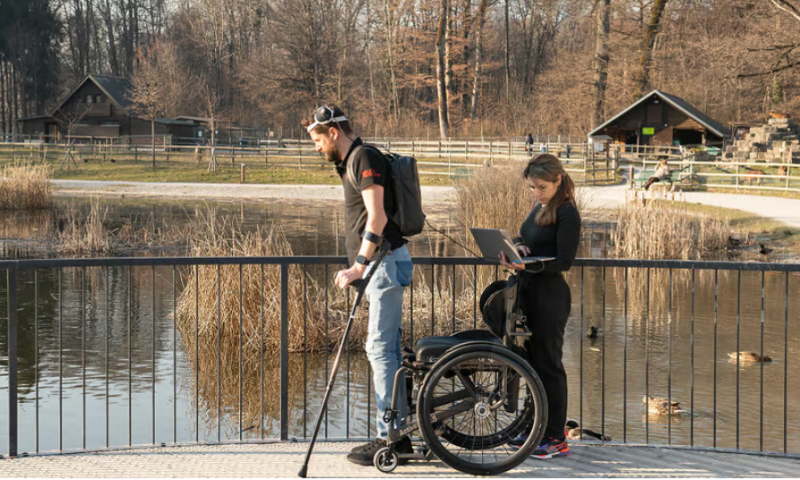After a motorbike accident that fractured his spinal cord and left him paralyzed from the waist down, 40-year-old Gert-Jan had one goal.
“For 12 years, I’ve been trying to get back on my feet,” Gert-Jan, who requested to be referred to by his first name only, said during a press briefing May 23. “My wish was to walk again, and I believed it was possible.”
Now, thanks to a first-of-its-kind system, he can. In a paper published May 24 in Nature, a research team led by scientists from Ecole Polytechnique Fédérale de Lausanne and the company NeuroRestore in Switzerland described how they developed a brain-spine interface, or BSI, that restores the severed connection between the brain and the spinal cord.
“With this project I regained again more function, a new level to train and more technology to train,” Gert-Jan said.
Walking is a complex process. To move the legs, the brain sends electrical signals down to the lumbar region of the spinal cord. Nerve cells there take the signals and translate them into specific instructions for the leg muscles, coordinating them in a way that facilitates motion. If communication between the brain and the lumbar region is cut off, the legs can no longer function, even if they’re otherwise healthy.
“Our idea was to reestablish this communication with a digital bridge that [could enable] communication between the brain and region of the spinal cord that is still intact, so it could control the leg muscles,” senior author Grégoire Courtine, Ph.D., described in a press video.
The BSI has several components. One is a pair of wireless implants surgically placed on the right and left sides of the brain’s sensorimotor cortex, a region that helps execute movement. Built based on WIMAGINE technology, they consist of 64 electrodes that record cortical activity, also known as electrocorticographic (ECoG) signals.The brain implants communicate with another implant in the spine via an antenna on a personalized headset, which sends ECoG signals to a portable processing unit worn as a backpack.
The processing unit—the “digital bridge”—detects signals that represent Gert-Jan’s thoughts of movement, converts them into stimulation commands, then sends them to a software program within the same unit. From there, they’re transferred down to the spine implant: a pulse generator made by Medtronic called Activa RC, typically used for deep brain stimulation in patients with Parkinson’s disease. This device interprets these electrical currents and sends them to nerve cells in the spinal cord, which activate the muscles so Gert-Jan can move.
“It was quite science fiction at the very beginning for me, but it became true today,” neurosurgeon Jocelyne Bloch, M.D., a senior author on the paper who implanted the BSI into Gert-Jan’s brain and spinal cord, said during the briefing.
Despite a complex programming process, the scientists were surprised to find that it took only a few minutes to calibrate the first models of the BSI, first author Henri Lorach, Ph.D., head of the brain spine interface unit at NeuroRestore, said during the briefing.
“After seven minutes of training, he was able to walk naturally using the system,” Lorach recalled. After 40 rehabilitation sessions with the device, “we observed functional recovery,” he said.
While other devices have given patients the ability to walk, this one gives finer, completely voluntary control. Gert-Jan can also move his hips, knees and ankle joints, giving him a more “natural” gait. Currently, he can walk with assistance 100 to 200 meters, depending on the day, and can stand without additional support for two or three minutes at a time, he said during the briefing. He can even paint.
“Last week, something needed to be painted and there was nobody to help me, so I took the walker and the paint and did it myself,” Gert-Jan recalled. “It helps a lot—not only painting of course, but in general.”
The breakthrough was made possible by understanding how to compensate for the loss of the brain-spine connection by tapping into specific types of neurons, in this case the ones that control the leg muscles, Courtine explained. Ideally, future advances will reverse other types of dysfunction that come with spinal cord injuries, like loss of bladder control and low blood pressure.
“Because we’re just understanding how and where to apply stimulation, we can start targeting other neurological functions that are important,” Courtine said. “Paralysis is the tip of the iceberg with spinal cord injury—you have all the other functions that are affected.”

